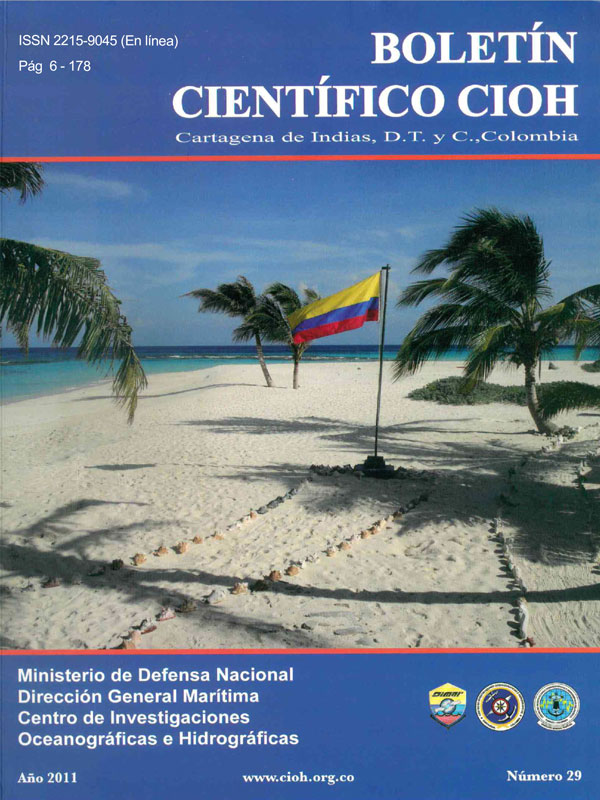Estimaciones de la biomasa zooplanctónica en la Bahía de Tumaco durante junio 2009 a junio 2010, Pacífico colombiano
DOI:
https://doi.org/10.26640/22159045.233Keywords:
Zooplankton wet biomass, dry biomass, Tumaco Bay, Colombian PacificAbstract
Biomass was measured by wet weight and dry weight of zooplankton samples collected in the Bay of Tumaco. Sampling was conducted during june 2009 – june 2010 and for four climatic periods. The highest average wet biomass and dry biomass were recorded in June 2009 and the lowest values in September 2009. Significant differences in the values of wet and dry biomass between sampling months. Taking into account the climatic periods the highest values were average during both wet to dry wet biomass to dry biomass, the lowest values were recorded during the wet to dry wet biomass and the wet period dry biomass. The four climatic periods showed no significant variations in the values of zooplankton biomass by wet weight but did show significant differences in the values of zooplankton biomass by dry weight.Downloads
References
[2] Lenz J. 2000. Introduction. In: Harris RP, Wiebe PH, Lenz J, Skjoldal HR, Huntley M (eds). Zooplankton Methodology Manual. London: Academic Press; 2000.p.1-32.
Boletín Científico CIOH NO. 29, ISSN 0120-0542, 122-128 (2011)128
[3] Tejada C. Clima marítimo de la bahía de Tumaco, un caso de aplicación del sistema de modelo integral de zonas costeras para Colombia [tesis de maestría]. Cantabria, España; Universidad de Cantabria, Grupo de Ingeniería Oceanográfica y de Costas; 2002.
[4] Garay Tinoco JA, Gómez López DI, Ortiz Galvis JR. Diagnóstico integral del impacto biofísico y socio económico relativo a las fuentes de contaminación terrestre en la bahía de Tumaco, Colombia y lineamientos básicos para un plan de manejo. Santa Marta: Proyecto del Programa de las Naciones Unidas para el Medio Ambiente (PNUMA – Programa de Acción Mundial PAM) y Comisión Permanente del Pacífico Sur CPPS. Instituto de Investigaciones Marinas y Costeras INVEMAR – Centro Control Contaminación del Pacífi co CCCP – Corporación Autónoma Regional de Nari-ño, CORPONARIÑO; 2006.
[5] Beers JR. Determinación de la biomasa del zooplancton. En: Boltovskoy D (ed). Atlas del Zooplancton del Atlántico Sudocciden-tal y Métodos de Trabajo con el Zooplancton Marino. Mar de Plata, Argentina: Publicación especial INIDEP; 1981. p.133-140.
[6] Postel L, Fock H, Hagen W. Biomass and abundance. In: Harris RP, Wiebe PH, Lenz J, Skjoldal HR, Huntley M (eds). Ices Zoo-plankton Methodology Manual. San Diego, California: Academic Press; 2000. p. 83-174.
[7] AR J. Biostatistical Analysis. New York: Prentice Hall; 1994.
[8] Omori M. Weight and chemical composition of some important oceanic zooplankton in the North Pacifi c Ocean. Mar. Biol. 1969; 3: 4 – 10.
[9] Nagao N, Toda T, Takahashi K, Hamasaki K. High ash content in netplankton samples from shallow coastal water: possible source of error in dry weight measurement of zooplankton biomass. J. Oceanogr. 2001; 57 (1): 105 – 107
Downloads
Published
Issue
Section
License
Attribution — You must give appropriate credit, provide a link to the license, and indicate if changes were made. You may do so in any reasonable manner, but not in any way that suggests the licensor endorses you or your use.
NonCommercial — You may not use the material for commercial purposes.
NoDerivatives — If you remix, transform, or build upon the material, you may not distribute the modified material.
No additional restrictions — You may not apply legal terms or technological measures that legally restrict others from doing anything the license permits.



